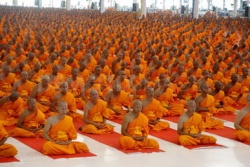Three Buddhist Councils
It is by means of three councils (Skt. saṃgīti; Wyl. bka' bsdu) that after the Buddha passed into parinirvana, his teachings were preserved without any alteration or loss.
The First Council (or Rajagriha Council)
One year after the parinirvana of the Buddha, Mahakashyapa gathered five hundred arhats in order to keep the teachings intact, at the great Banyan cave which was on the bank of a hot spring close to Vulture's Peak near Rajagriha. Ananda, Mahakashyapa and Upali recited every word of the Buddha that they had heard, respectively on the Sutra, Abhidharma and Vinaya. They would begin by saying, "Thus have I heard" or "This is how the Buddha spoke."
King Ajatashatru sponsored the first council.
The Second Council (or Vaishali Council)
The Second Council took place 110 years after the parinirvana of the Buddha. The arhat Yashah chiefly gathered seven hundred arhats in Vaishali, because of monks who, finding the rules of disciplined laid down by the Buddha too strict, wanted to introduce ten new rules (one example of what they wanted to introduce was: If you had done some negative action, then it would be sufficient to fold your hands to the heart and to say something like “hulu, hulu” and then it would be purified and you wouldn’t need to do anything else.) Since none of the arhats saw these rules to be part of the teachings of the Buddha, they were rejected.
The Third Council (or Pataliputra Council)
The Third Council took place 137 or 160 years after the parinirvana of the Buddha. Five hundred arhats led by Arya Parsva and four hundred panditas led by Vasumitra gathered in Kashmir to decide which of the eighteen schools of shravakas that had formed, were true followers of the Buddha, and which were not. Based on one of the prophecies told in the Sutra of Garland of Gold the council had to come to the conclusion that each of these eighteen sections of shravakas were all correct in their line of thought and that the teachings that they were following were all the teachings of Buddha Shakyamuni.
The Sutra tells about ten dreams that the King Kirkin had, at the time of the previous Buddha, Kashyapa. In this dream the King saw a long piece of cloth and there were eighteen men who were each trying to get a piece of the cloth. In the end each one got a piece and there were eighteen pieces of cloth. The Buddha Kashyapa interpreted this as, “This dream hasn’t anything to do with your own life as the king. But at the time of Buddha Shakyamuni, there will be eighteen different schools of shravakas. But one shouldn’t think that their views are in contradiction with the teachings of Buddha Shakyamuni. In fact, the whole of Buddha Shakyamuni’s teaching remains pure and intact, and each of the paths that they are following is the true path and leads to the true fruition. So one mustn’t think that some are good and some are bad. Each of the paths belongs to the true path of the Buddha.”
During this Third Council, they also completed their previous work on the gathering of the Vinaya, the Sutras, and the Abhidharma. During the previous councils, they had started to write down these three sections of the Buddha’s teachings. By the third council some of these works were already written down. So during the Third Council they corrected the proofs of what had been written down so that these teachings were now pure and could be decisively considered as being the Buddha’s teaching. We can say that after the Third Council was over, all of the Buddha’s teachings were finally written down and corrected.
The Third Council was convened under the patronage of Emperor Ashoka.
